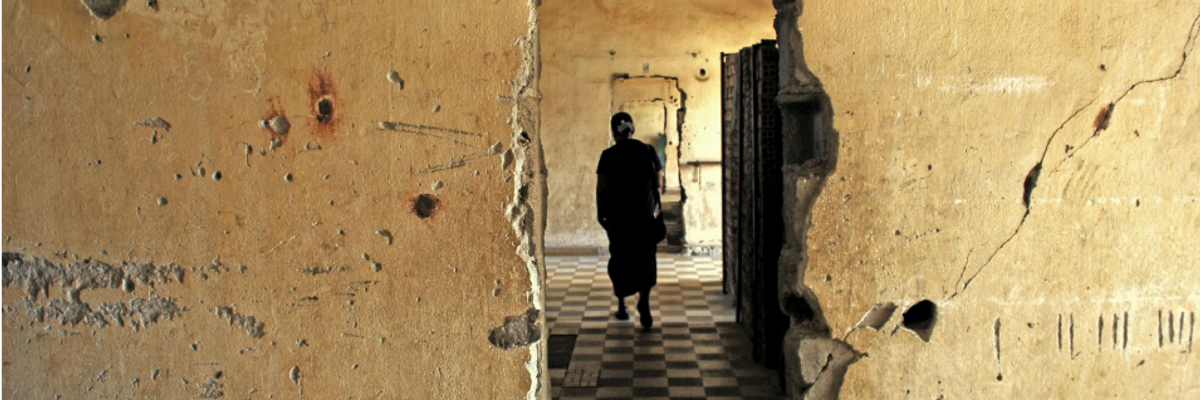One of the biggest frauds surrounding the Islamic State in Syria (ISIS) is that its emergence was unforeseen, indeed, unforeseeable. Nothing could be further from the truth. Forty-five years ago, the U.S. created another ISIS--a virulent, apocalyptic movement of anti-Western fundamentalists--during the Vietnam War. Its name was the Khmer Rouge.
In the 1968 presidential campaign Richard Nixon had promised to end the Vietnam War, by achieving "peace with honor." Within months of assuming office in January 1969, he began a secret campaign bombing neighboring Cambodia. The purpose was to flush out sanctuaries used by the North Vietnamese army to launch attacks into South Vietnam.
Nixon did this without informing Congress of the War's escalation to another country. Indeed, Secretary of Defense Melvin Laird opposed the bombings. Henry Kissinger accused Laird of "bureaucratic pussy-footing" and instructed the Joint Chiefs of Staff to carry out the campaign without Laird's knowledge. They did.
The campaign lasted until 1973, when it finally became public. Over its duration, the U.S. dropped more than 400,000 tons of bombs on Cambodia, killing more than 500,000 people, almost all of them innocent civilians.
Most importantly, the social fabric of Cambodian society was utterly destroyed. Hundreds of simple farming villages were simply erased from the map by the carpet bombings of U.S. B-52s. Into the breach caused by this devastation stepped the Khmer Rouge.
Before the bombings, the Khmer Rouge were a marginal communist sect of perhaps 4,000 members. They opposed Cambodian premier, Lon Nol, an ally of the U.S. They used the fact of the U.S. bombings as a recruiting tool to build a national cadre of militant activists to overturn Nol's government.
Chhit Do, a Khmer official, commented later, "Every time there was a bombing, we would take the people to see the craters. Sometimes they literally shit their pants. That was what made it so easy for the Khmer Rouge to win the people over." Within five years the ranks of the Khmer Rouge had swelled to over 70,000.
Under the leadership of Pol Pot, one of the greatest murderers in history, the Khmer Rouge toppled the Cambodian government in 1975, thus beginning the Cambodian Genocide. They evacuated the cities, moving millions of people to the country side, to prison-farming communities that would become known as "killing fields."
They imposed a radical, anti-western ideology that was a nativist mix of Marxism, xenophobia, and rabid anti-modernism. Intellectuals, doctors, teachers, engineers, were ruthlessly tortured. Anyone with Westernized skills or education was murdered.
By the time it was ended, in 1979, more than 2,000,000 people were killed, either by murder, the after-effects of torture, or of having been worked to death in the killing fields. This represented 25% of the entire population of the country, the largest proportional genocide in modern history.
The Khmer Rouge and the genocide that followed its ascension were the direct result of the destruction of an existing society while radical activists were waiting in the wings. It is the political incarnation of the ancient (Aristotelian) wisdom, "Nature abhors a vacuum." The creation of ISIS is of the identical cloth.
Before the U.S. invasion of Iraq in 2003, Saddam Hussein had held together an eclectic mix of Shi'ites, Sunnis, Kurds, and small smatterings of Christians, Zoroastrians, Alawites and secularists. It was never a pretty picture, but it was good enough for the U.S., which had backed Hussein and his Baathist party overthrow of nationalist leader Kareem Qaseem in 1963. Saddam Hussein was our guy.
But the U.S. invasion and subsequent war ended up killing more than 1,000,000 Iraqis and creating refugees of more than 4,000,000. The U.S. use of depleted uranium weapons left Iraq the most radioactive geography on earth. The U.S. destroyed the most prosperous secular Arab regime in the world, which was exactly the intent.
Into the breach swept al-Qaeda, which had not existed in Iraq prior to the U.S. invasion. For the Khmer Rouge's fanatical communism, simply substitute al-Qaeda's fanatical Islamism. Both are fundamentalist anti-Western ideologies that used the destruction wrought by the United States as recruiting tools for their militarized messianic nihilism.
After its failure in Iraq, the U.S. went on to try to destabilize the secularist regime of Bashar al-Assad in Syria, next door to Iraq. As it had done in Iraq, and indeed, as it had done in Cambodia, it kicked out the props of a repressive but effective regime that had maintained order among disparate peoples for decades.
To do so, it recruited, funded, and provisioned the descendants of al-Qaeda in Iraq. It pressed its Arab State allies, Saudi Arabia, Qatar, and Jordan, and Turkey to provide funding, weapons, training bases, sanctuaries, and intelligence for the insurgents, all for the purpose of overturning the Assad regime. It maintained the public relations fiction that it was supporting "moderate rebels," all the while knowing that the weapons it supplied ended up in the hands of the most radical jihadists.
But, like the brooms that got out of control in The Sorcerer's Apprentice, the "rebels" soon broke their leashes, announcing the formation of ISIS and then ISIS's descendant, the Islamic State. It was but a short step from there to YouTube videos of the beheading of Western journalists, the capture of masses of Western weapons, and the mass murders of apostates, heretics and infidels.
The significance of ISIS, or IS, is difficult to overstate. It represents the destruction of the Sykes-Picot arrangement that has defined nation states in the Middle East since 1919 at the end of World War I. The U.S. wants to pretend innocence, even shock--SHOCK!--at its emergence.
In fact, the destruction of existing order, leaving chaos in its wake, is precisely the U.S. strategy for dealing with its waning influence in the Middle East--witness Iraq, Syria, Afghanistan, Somalia, Yemen, and Libya. ISIS is simply the inevitable blowback. It is the Khmer Rouge writ recent.
